Key Takeaways
AI Travel Itinerary apps are transforming travel planning by offering personalized, time-saving, and automated solutions for modern travelers.
Developing a successful app requires careful planning, feature selection, AI integration, and a robust tech stack.
A step-by-step approach from market research and user personas to tech stack, AI integration, and testing is key to building a scalable, user-friendly AI Travel Itinerary app.
Monetization strategies such as subscriptions, affiliate bookings, and premium AI services can generate sustainable revenue.
Overcoming challenges like AI complexity, data security, and user experience design is crucial for long-term success.
Partnering with an experienced development partner like JPLoft ensures your AI Travel Itinerary app development takes place effectively to meet the market demands.
Planning trips is exciting but often overwhelming. Juggling flights, hotels, activities, and transport can take hours. That’s where AI travel itinerary apps simplify everything.
By analyzing preferences, budget, and travel history, these apps create personalized trip plans in seconds, removing the stress of manual research. Unlike basic tools, an AI Travel Itinerary app learns from users, adapts suggestions, and ensures a seamless journey.
So, how to build an AI Travel Itinerary App? Start by defining your target audience, selecting the right tech stack, integrating AI/ML algorithms for personalization, and adding features like bookings, maps, and recommendations.
This guide to build an AI travel itinerary app explores features, costs, challenges, and the roadmap to building a successful AI travel solution.
What is an AI Travel Itinerary App? Market Growth & Statistics
Businesses exploring how to create a travel app are increasingly adopting AI-driven solutions to enhance personalization and stay ahead in the competitive travel market.
An AI Travel Itinerary app is a smart travel planner that uses artificial intelligence and machine learning to craft personalized trip schedules. Unlike traditional planning tools, it analyzes user preferences, travel history, reviews, and real-time data like weather or local events to deliver optimized recommendations. Simply put, it’s AI designed to generate a travel itinerary personalized for every traveler.
The global AI in travel market is witnessing rapid growth, fueled by personalization and automation demands. Here are some key insights:
- Market Value: The AI in tourism market is projected to reach USD 13.38 billion by 2030, up from USD 2.95 billion in 2024.
- Growth Rate: The global AI in tourism market is expected to grow at a CAGR of 28.7% from 2024 to 2030, reaching USD 13.38 billion by 2030.
- Adoption: Approximately 40% of global travelers are already using AI tools for travel planning, with over 60% open to trying them.
- User Demand: A survey indicates that 70% of travelers prefer apps offering personalized recommendations powered by AI.
This surge highlights how essential AI is becoming in travel planning. Technologies like AR in travel apps are also creating immersive trip experiences, further boosting the relevance of AI-powered itinerary systems.
How Does an AI Travel Itinerary App Work?
With evolving travel app development trends, AI Travel Itinerary apps are revolutionizing trip planning by combining artificial intelligence, machine learning, and natural language processing (NLP).
Unlike traditional planning, which demands hours of research, these apps analyze traveler preferences, budget, schedule, and even sentiment from reviews to recommend optimized destinations, activities, and accommodations.
Here’s how an AI app for travel itinerary typically works:
-
User Input: Travelers begin by entering destinations, travel dates, interests, budget, and special requirements. Some apps connect to social media or past travel history to better understand user preferences.
-
Data Aggregation and Analysis: The AI engine scans flights, hotels, restaurants, attractions, local events, weather, and user reviews. Advanced algorithms detect patterns and prioritize options that best match the traveler’s profile.
-
Recommendation Engine: At this stage, the app generates a personalized itinerary, suggesting sightseeing, dining, transport routes, and hidden local gems. Using AI to generate travel itinerary, the app ensures realistic schedules, minimizing travel time while maximizing experiences. Continuous learning refines recommendations based on user behavior, preferences, and even seasonal trends.
-
Integration of Advanced Features: Many apps now include real-time updates, push notifications, interactive maps, and chatbots. The rise of AI in hospitality enhances experiences by integrating smart recommendations with bookings, concierge services, predictive pricing, and seamless engagement. A travel itinerary app can manage loyalty programs, travel insurance options, and safety advisories, making trips stress-free and fully optimized.
With these processes, an AI Travel Itinerary app doesn’t just plan trips, it creates dynamic, adaptive, and fully personalized journeys. Travelers get day-by-day schedules, alternate route suggestions, and insights tailored to their interests. By combining user preferences, real-time data, and analytics, travel itinerary AI apps exemplify the future of travel planning.
Why Create an AI Travel Itinerary App in 2025?
Building an AI Travel Itinerary app is no longer a luxury; it’s becoming essential for travel businesses and startups aiming to stand out. Here’s why creating one can transform your business and meet the evolving needs of modern travelers:
1. Personalized Travel Experiences
AI enables highly customized itineraries based on traveler preferences, past behavior, and interests.
From suggesting local hotspots to planning realistic daily schedules, your app ensures each journey is unique and enjoyable.
This personalization is a major reason why travelers increasingly choose the best travel apps that can anticipate their needs rather than relying on generic recommendations.
2. Time-Saving Automation
Planning a trip manually can take hours, or even days, as travelers research flights, accommodations, restaurants, and activities.
An AI Travel Itinerary app automates this entire process, generating optimized plans in seconds.
By providing real-time updates and suggestions, the app reduces decision fatigue and enhances the overall travel experience.
3. Competitive Edge in the Market
With AI transforming the travel industry, businesses that adopt intelligent solutions can differentiate themselves.
Developing an AI travel app allows you to stand out from competitors and provide a superior service.
Entrepreneurs exploring how to create an app like Omio can gain insights into leveraging AI for smooth route planning, bookings, and multi-modal travel options.
4. Enhanced Revenue Opportunities
AI-driven recommendations not only improve user experience but also increase monetization possibilities.
Integrated booking, premium recommendations, and partnerships with hotels, transport providers, and local attractions can generate significant revenue streams for your business.
Additionally, targeted promotions and personalized offers can further boost earnings while keeping users engaged and satisfied.
5. Reduced Risk of Failure
Many traditional travel apps fail because they don’t offer personalization, automation, or timely updates. By using AI travel app itinerary app development best practices, developers ensure higher retention and satisfaction rates.
By understanding why online travel apps fail, helps developers make an AI travel itinerary app that focuses on personalization, automation, and updates.
Features to Include in an AI Travel Itinerary App
A successful AI Travel Itinerary app development relies on a robust set of features that enhance user experience, streamline planning, and ensure reliability.
Here are the top travel app features to include in an AI travel itinerary app:
► Smart Itinerary Planning
The core functionality is the AI-powered itinerary generator. Users input destinations, travel dates, and preferences, and the app automatically crafts optimized schedules.
Incorporating predictive travel itinerary AI enables the app to suggest the optimal times for sightseeing, dining, and transit. Including features like dynamic updates and push notifications ensures travelers stay informed and organized.
► Personalized Recommendations
AI algorithms analyze user behavior, previous trips, and interests to provide tailored suggestions for hotels, restaurants, attractions, and activities.
Personalized recommendations make travelers feel understood and increase app engagement and loyalty.
► Real-Time Updates & Notifications
Flight delays, traffic changes, or sudden weather shifts can disrupt travel plans. Your app should provide real-time alerts to adjust itineraries instantly.
Integrating GPS tracking and smart notifications improves overall efficiency and user satisfaction.
► Secure Booking & Payment Options
Users expect a safe and seamless booking experience.
Implementing secure payment gateways, data encryption, and GDPR compliance ensures travel app security while enabling bookings for hotels, flights, and local experiences directly within the app.
► Social & Sharing Features
Sharing itineraries with friends or family enhances the social experience and encourages organic app promotion.
Users can save and share plans via messaging apps or social media platforms.
► Offline Mode & Multi-Platform Access
Travelers often face limited connectivity. Offline access to itineraries, maps, and essential travel info ensures uninterrupted usage.
Cross-platform compatibility (iOS, Android, web) further broadens accessibility.
► Review & Feedback Integration
In-app reviews and ratings allow users to share experiences, helping others make informed decisions.
By studying apps like how to make an app like tripadvisor, developers can integrate intuitive feedback systems to build credibility and trust.
► Multi-Language Support
Global travelers require multilingual options. AI can dynamically translate content, making the app more user-friendly for diverse audiences.
This guide to build an AI travel itinerary app ensures all essential features are included effectively.
Here is a summary of features to look at in the table below.
|
Feature |
Description |
|
AI Itinerary Planner |
Creates personalized travel plans based on preferences, history, and budget. |
|
Real-Time Booking |
Book flights, hotels, cabs, and activities instantly. |
|
Geo-Location Services |
Suggests nearby attractions, restaurants, and transport options. |
|
Multi-Currency & Payments |
Supports global payments with live currency conversion and secure gateways. |
|
Offline Access |
Lets users view itineraries, maps, and tickets without internet. |
|
Reviews & Ratings |
Provides user feedback and ratings for informed decisions. |
|
Predictive Pricing |
Uses AI to forecast flight and hotel prices, helping users save money. |
|
24/7 Chatbot Assistance |
Offers instant support for bookings, cancellations, or FAQs. |
|
Loyalty & Rewards |
Integrates with loyalty programs, cashback, and discounts. |
|
Social Sharing |
Allows users to share trips and experiences on social media. |
|
AR Navigation |
Provides augmented reality directions for airports, cities, and landmarks. |
|
Multi-Language Support |
Makes the app accessible to a global audience. |
How to Build An AI Travel Itinerary App: Step-by-Step Guide
Building an AI Travel Itinerary app requires careful planning, robust technology, and a clear understanding of traveler needs. Whether you’re a startup or an established travel business, following a structured roadmap to build an AI travel itinerary app ensures your app is functional, user-friendly, and scalable.
Below, we break down the essential steps to develop an AI travel itinerary app successfully.
Step 1: Market Research and Planning
Before diving into development, comprehensive research is critical. Understanding target audiences, market gaps, and competitor offerings forms the foundation for a successful app.
Identify key pain points in traveler experiences, such as long planning times, complex bookings, or lack of personalization, and define how your AI travel itinerary app solves them.
A] Define User Personas
Creating detailed user personas helps your team visualize the end users. Include factors like age, travel frequency, preferences, budget, and tech proficiency to tailor features and interfaces effectively.
B] Analyze Competitors
Study popular travel apps, understand what works, and identify shortcomings. This analysis informs your unique value proposition, helping your app stand out in a crowded market.
C] Establish Goals and KPIs
Set clear objectives, such as user acquisition, engagement, and retention metrics. Define KPIs that track success across downloads, usage patterns, and conversion rates for bookings.
D] Prepare a Feature Roadmap
Draft a prioritized list of features, including itinerary generation, AI recommendations, real-time updates, booking integration, offline access, and multi-language support. A well-defined roadmap guides development efficiently.
Step 2: Choosing the Right Mobile App Tech Stack
Selecting the right mobile app tech stack is crucial for AI integration and smooth app performance. The tech stack defines the backbone of your AI Travel Itinerary app development.
Choosing appropriate technologies ensures scalability, performance, and seamless integration with AI algorithms.
A] Backend Development
Use reliable backend frameworks like Node.js, Django, or Ruby on Rails to manage databases, API integration, and AI logic. Robust backend architecture ensures smooth operation and real-time updates.
B] Frontend Development
Frameworks such as React Native or Flutter enable cross-platform compatibility, offering native-like performance on both iOS and Android devices. A responsive frontend enhances user experience.
C] AI & Machine Learning Integration
Implement machine learning models to analyze user preferences, travel patterns, and historical data. These algorithms allow the app to build an AI travel itinerary tailored to each user.
D] Cloud Infrastructure
Use cloud services like AWS, Google Cloud, or Azure for hosting, storage, and AI computations. Cloud solutions ensure scalability, security, and reliability during peak usage periods.
Step 3: Mobile App Design and UI/UX
Effective mobile app design ensures the app is intuitive, visually appealing, and ready for AI-driven features. A travel app must be visually appealing and easy to navigate.
A] Wireframing
Create wireframes to outline screens, layout, and flow. Wireframes help visualize the user journey and detect issues early.
B] Prototyping
Develop interactive prototypes to simulate app behavior. Continuous mobile app prototyping during development helps detect bugs and optimize AI recommendation flows efficiently.
C] UI/UX Elements
Focus on minimalistic design, readable fonts, and accessible navigation. Highlight AI-generated itineraries with clean layouts, intuitive icons, and color-coded schedules.
D] Responsive Design
Ensure the app functions seamlessly across devices. Users should experience consistent performance on smartphones, tablets, and larger screens.
Step 4: Development and Coding
With the design finalized, development begins. This phase transforms wireframes and prototypes into functional code.
A] Backend Implementation
Integrate AI modules, databases, APIs, and booking engines. Ensure secure storage of user data and seamless connectivity with travel partners.
B] Frontend Development
Implement UI components, screens, and interactive features. Connect frontend to backend APIs for dynamic itinerary generation and real-time updates.
C] AI Algorithm Deployment
Deploy machine learning models to recommend destinations, attractions, hotels, and routes. Continuously refine AI logic based on user interactions for smarter suggestions.
D] API Integrations
Connect with third-party services for flights, hotels, transport, and local attractions. Reliable API integration enhances user experience and broadens app capabilities
Step 5: Testing and Quality Assurance
Comprehensive travel app testing ensures AI-generated itineraries are accurate and app performance remains consistent across devices. Testing ensures your app is reliable, fast, and bug-free.
A] Functional Testing
Check all features, buttons, screens, and AI recommendations for correct operation.
B] Performance Testing
Test app speed, load times, and response under varying network conditions. Ensure seamless experience during peak travel seasons.
C] Usability Testing
Observe real users interacting with the app. Gather feedback to refine navigation, AI suggestions, and itinerary displays.
D] Security Testing
Validate payment gateways, data encryption, and compliance with privacy laws to protect user information.
Step 6: Hiring Developers and Team Setup
Many startups prefer to hire dedicated developers to leverage their expertise in AI and travel app development. A competent development team is essential for building a feature-rich AI travel app.
A] Hire Dedicated Developers
Specialized AI and mobile app developers can streamline development and ensure integration of advanced features.
B] Team Structure
Include frontend, backend, AI specialists, UI/UX designers, QA testers, and project managers. A well-coordinated team ensures timely delivery.
C] Collaboration Tools
Use tools like Jira, Trello, and Slack for task management and communication. Transparency improves productivity.
D] Outsourcing vs In-house
Evaluate whether to hire freelancers, agencies, or in-house staff based on project complexity and budget.
Step 7: Maintenance and Post-Launch Support
Investing in reliable mobile app maintenance services ensures smooth AI operation, up-to-date features, and sustained user satisfaction. Launching the app is just the beginning. Regular updates, AI refinement, and user support are critical for long-term success.
A] Bug Fixes and Updates
Continuously monitor user feedback and fix any issues promptly.
B] AI Model Improvement
Regularly retrain AI algorithms to enhance recommendations based on new data and trends.
C] Feature Expansion
Add new features such as multi-modal transport integration, travel alerts, or loyalty programs to keep users engaged.
D] Support Services
Provide 24/7 support via chatbots or live agents to resolve user queries efficiently.
What’s the Cost to Create an AI Travel Itinerary App?
The total cost to create an AI Travel Itinerary app ranges between $15,000 and $120,000+, depending on features, platforms, design complexity, and AI integration.
Building an AI Travel Itinerary app requires investment across several components, from AI modules and smart recommendations to design, development, and post-launch maintenance.
The total cost can vary significantly depending on the complexity, platforms, and technology used. Below is a detailed guide to help you estimate expenses realistically.
1. Basic AI Travel Itinerary App
A simple app with essential features like personalized itineraries, basic AI recommendations, and limited integrations is suitable for startups or MVPs.
-
Price Range: $15,000 – $30,000
-
Includes core AI modules, basic UI/UX, and single-platform support (iOS or Android).
-
Ideal for testing market response before scaling.
The cost to develop a travel app for a basic MVP can start from $15,000, depending on features and AI integration.
2. Mid-Level AI Travel Itinerary App
A more robust solution includes advanced AI for itinerary optimization, multi-platform support, booking integrations, push notifications, and real-time updates.
-
Price Range: $35,000 – $60,000
-
Covers comprehensive design, AI modules, cross-platform compatibility, and moderate backend complexity.
-
Suitable for small to medium-sized travel businesses aiming for better user engagement.
Developers often benchmark their budgets against the cost to create an app like Agoda to ensure features and AI algorithms are competitive.
3. Advanced AI Travel Itinerary App
High-end apps with sophisticated AI, predictive recommendations, AR/VR experiences, multi-lingual support, and seamless third-party integrations fall under this category.
-
Price Range: $70,000 – $120,000+
-
Includes custom AI models, premium design, real-time analytics, and post-launch support.
-
Perfect for enterprises or agencies seeking a fully scalable solution.
For global-scale projects, the cost to develop a travel app like Visit Dubai can reach $100,000 or more due to AI complexity and extensive integrations.
4. Additional Cost Considerations
-
AI Model Training: $5,000 – $20,000 depending on data volume and sophistication.
-
Maintenance & Updates: $500 – $2,000/month to ensure continuous improvements.
-
Third-Party API Integration: $2,000 – $10,000 depending on booking engines or mapping services.
-
Design and Prototyping: $3,000 – $8,000 for UI/UX and interactive prototypes.
Overall, mobile app development cost varies based on platform, features, and AI complexity.
Consolidated Cost Table for AI Travel Itinerary App Development
|
App Type |
Key Features |
Price Range |
|
Basic |
Core AI, single platform, essential itinerary features |
$15,000 – $30,000 |
|
Mid-Level |
Advanced AI, multi-platform, booking integrations, push notifications |
$35,000 – $60,000 |
|
Advanced |
Premium AI, predictive analytics, AR/VR, multi-lingual, full integrations |
$70,000 – $120,000+ |
|
AI Model Training |
Custom AI, data processing |
$5,000 – $20,000 |
|
Maintenance & Updates |
Bug fixes, AI refinement, feature upgrades |
$500 – $2,000/month |
|
Third-Party API Integration |
Flights, hotels, maps |
$2,000 – $10,000 |
|
Design & Prototyping |
UI/UX, wireframes, interactive prototypes |
$3,000 – $8,000 |
How to Monetize an AI Travel Itinerary App?
An AI Travel Itinerary app isn’t just about simplifying trips; it can also become a strong revenue generator when monetized smartly. Here are the most effective travel app monetization strategies. Do have a look:
A] Subscription Plans
Offer tiered subscription models where users pay for premium features such as advanced itinerary customization, AI-driven travel insights, or offline access. Subscriptions not only generate recurring income but also boost user retention by delivering consistent value through exclusive features.
B] In-App Advertisements
Targeted ads from airlines, hotels, and local service providers can generate steady revenue. Since the app already gathers user preferences, ads remain highly relevant without disrupting the experience.
C] Affiliate Commissions
Earn commissions by integrating booking engines for flights, hotels, and tours. Each completed booking through your app provides a percentage-based return, making this a low-effort but impactful model.
D] Freemium + Microtransactions
Provide a free version of the app with basic features while locking premium features behind micro-purchases. For example, users may pay a small fee to unlock curated local experiences or AI-driven multi-day itineraries. By studying how to develop an app like Kayak, developers can optimize this freemium approach to maximize engagement.
E] AI-Powered Travel Agent Services
Take monetization a step further by offering personalized travel assistant services, real-time chat support, predictive AI recommendations, and VIP concierge bookings. Scaling toward this model positions your product similar to how to build an AI travel agent, creating higher-value revenue streams.
F] Sponsored Partnerships
Collaborating with local businesses, restaurants, and event organizers opens another revenue channel. Sponsored listings inside the itinerary recommendations benefit both users and partners.
Challenges to Make an AI Travel Itinerary App
Developing an AI travel itinerary app comes with its own set of complexities. From integrating advanced AI algorithms to ensuring smooth user experiences, several hurdles can affect timelines and budgets. Here are the key challenges to keep in mind:
1] Handling AI Complexity
Training AI models to generate accurate travel plans requires large volumes of real-time and historical travel data. Ensuring these models provide relevant recommendations while adapting to user preferences is one of the biggest travel app development challenges faced by startups and enterprises alike.
2] Data Privacy and Security
Since users share sensitive data like location, payment methods, and travel history, securing this information is crucial. Apps must implement GDPR compliance, end-to-end encryption, and strict authentication layers to gain user trust.
3] Scalability with Growing Users
As the user base grows, so does the demand for real-time AI processing and bookings. Many businesses take cues from how to develop an app like Expedia, where large-scale infrastructure supports millions of transactions daily. Without scalable backend architecture, performance bottlenecks can harm user experience.
4] Third-Party Integration Issues
AI travel apps often rely on APIs from airlines, hotels, and local services. Any downtime or mismatch in data can cause inaccurate recommendations, making reliability a constant concern.
5] UI/UX Design Limitations
Travelers expect intuitive navigation, clean layouts, and interactive elements. Balancing advanced AI features with simplicity is not easy. Drawing lessons from how to design a travel app, developers must ensure that innovation doesn’t compromise usability.
6] High Development & Maintenance Costs
AI-powered apps demand skilled developers, cloud infrastructure, and ongoing maintenance. Businesses should factor in recurring expenses for AI retraining, bug fixes, and feature updates.
Partner With JPLoft and Create Your AI Travel Itinerary App
Turning your idea into a fully functional AI travel itinerary app requires the right expertise and technology partner. At JPLoft, we specialize in delivering end-to-end solutions from concept and design to development and launch, powered by the latest AI, ML, and NLP capabilities.
Whether you want to make an AI travel itinerary app for MVP testing or a feature-rich global platform, our team ensures seamless performance, robust security, and scalability. As a leading travel app development company, we help you craft innovative, user-centric solutions that stand out in the competitive travel market.
Let’s collaborate to bring your AI-powered travel vision to life.
Conclusion
The rise of AI travel itinerary apps is reshaping how people plan and experience their journeys. By combining AI-driven personalization with real-time updates and seamless booking integrations, these apps save time and enhance convenience for modern travelers.
For businesses, this innovation opens new opportunities to attract users, generate revenue, and stay ahead of the competition. From features and costs to monetization strategies and challenges, this guide highlights the essentials you need to know before building your solution.
As AI continues to evolve, travel apps powered by intelligent automation will only grow more valuable, making now the best time to invest.
FAQs
It’s a mobile application that uses artificial intelligence to automatically generate personalized travel plans based on user preferences, budget, and trip details.
The process involves defining app goals, choosing the right tech stack, integrating AI/ML models for personalization, designing intuitive UI/UX, and testing the solution thoroughly before launch. Partnering with experienced developers speeds up this process.
The cost can range from $15,000 for a basic MVP to $120,000+ for a fully advanced solution with AI, integrations, and multi-platform support.
These apps can be monetized through subscriptions, ads, affiliate bookings, premium features, or AI-powered travel agent services.
Depending on complexity, development may take 4–6 months for a basic version and 8–12 months for an advanced platform.





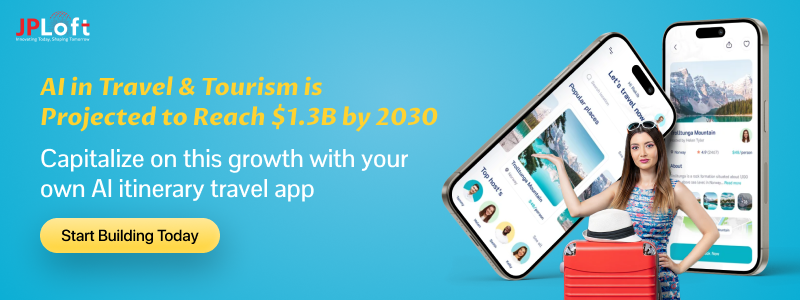
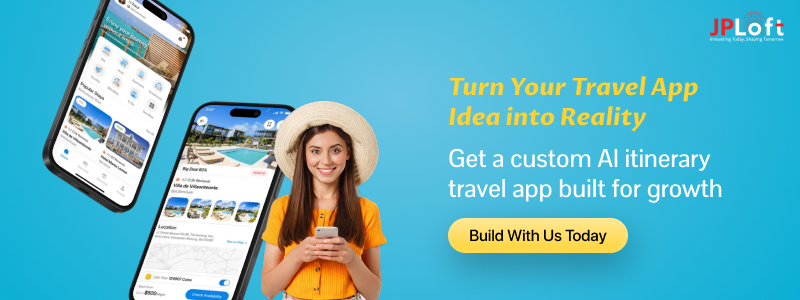

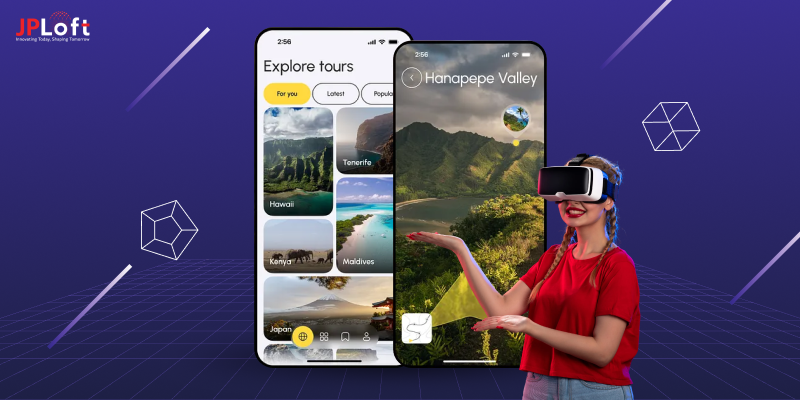
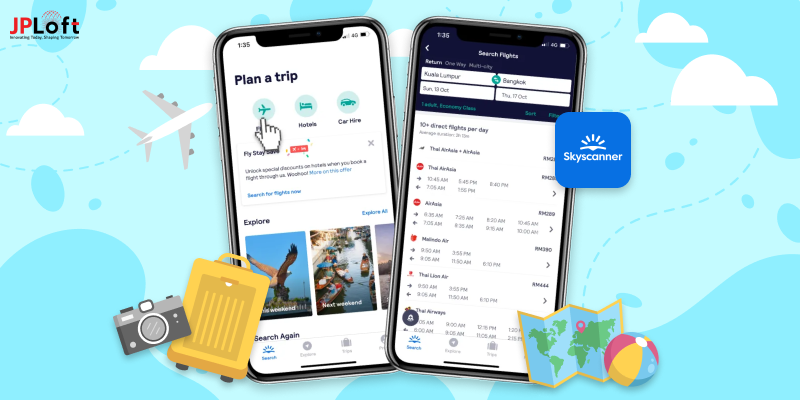
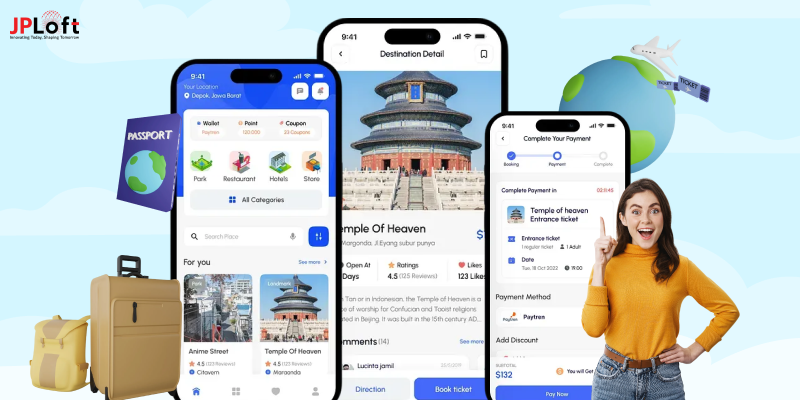


Share this blog